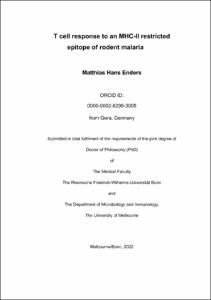T cell response to an MHC-II restricted epitope of rodent malaria

T cell response to an MHC-II restricted epitope of rodent malaria

| dc.contributor.advisor | Wilhelm, Christoph | |
| dc.contributor.author | Enders, Matthias Hans | |
| dc.date.accessioned | 2022-02-01T10:34:42Z | |
| dc.date.available | 2022-02-01T10:34:42Z | |
| dc.date.issued | 01.02.2022 | |
| dc.identifier.uri | https://hdl.handle.net/20.500.11811/9587 | |
| dc.description.abstract | Malaria is caused by different Plasmodium species that can infect a variety of animals including humans and rodents. The life cycle of these parasites is complex and includes a liver stage followed by a blood-stage in their vertebrate hosts. While the host’s immune response against each of these stages is incompletely understood, CD4 T cells are known to play an important role in immunity to Plasmodium infection during both stages. This project aims to examine the specific CD4 T cell response to a novel MHC II-restricted epitope in Plasmodium infection in C57BL/6 mice, and to characterise the protective capacity of these T cells. To this end, we made use of a recently generated TCR transgenic mouse line, termed PbT-II, which responds to a so far unknown Plasmodium derived epitope. In this project, the PbT-II epitope was identified as derived from heat shock protein 90, residues 484 to 496 (Hsp90484-496 or abbreviated DIY). Different priming methods, such as injection of an anti-Clec9A antibody attached to the Hsp90 epitope (αClec9A-DIY), infection with P. berghei ANKA (PbA) infected red blood cells (iRBCs) or immunisation with radiation attenuated PbA sporozoites (RAS), were used to characterise PbT-II memory cell formation. Results revealed the formation of memory PbT-II cells expressing surface markers associated with central memory T cells (TCM), effector memory T cells (TEM) and tissue resident memory T cells (TRM). Given the importance of tissue-resident memory T cells in peripheral immunity, mainly studied in CD8 T cells, we focused our study on the formation and function of CD4 TRM cells in the liver. Parabiosis studies using RAS vaccinated mice confirmed the liver residency of a CD69+ PbT-II cell population. Gene expression profile analysis revealed that these CD4 T cells expressed a core gene signature similar to that of CD8 resident memory T cells. Furthermore, differences in the gene expression profile of PbTII TRM cells generated via different protocols, suggested lineage specific effector mechanisms, such as IL-4 production or perforin expression, for subsets of CD4 TRM cells in the liver. | en |
| dc.language.iso | eng | |
| dc.rights | In Copyright | |
| dc.rights.uri | http://rightsstatements.org/vocab/InC/1.0/ | |
| dc.subject.ddc | 570 Biowissenschaften, Biologie | |
| dc.subject.ddc | 610 Medizin, Gesundheit | |
| dc.title | T cell response to an MHC-II restricted epitope of rodent malaria | |
| dc.type | Dissertation oder Habilitation | |
| dc.publisher.name | Universitäts- und Landesbibliothek Bonn | |
| dc.publisher.location | Bonn | |
| dc.rights.accessRights | openAccess | |
| dc.identifier.urn | https://nbn-resolving.org/urn:nbn:de:hbz:5-65337 | |
| ulbbn.pubtype | Erstveröffentlichung | |
| ulbbnediss.affiliation.name | Rheinische Friedrich-Wilhelms-Universität Bonn | |
| ulbbnediss.affiliation.location | Bonn | |
| ulbbnediss.affiliation.otherLocation1 | Melbourne | |
| ulbbnediss.affiliation.otherName1 | Universität Melbourne | |
| ulbbnediss.thesis.level | Dissertation | |
| ulbbnediss.dissID | 6533 | |
| ulbbnediss.date.accepted | 13.01.2022 | |
| ulbbnediss.institute | Mathematisch-Naturwissenschaftliche Fakultät : Fachgruppe Molekulare Biomedizin / Life & Medical Sciences-Institut (LIMES) | |
| ulbbnediss.fakultaet | Medizinische Fakultät | |
| dc.contributor.coReferee | Heath, William R. | |
| dcterms.hasSupplement | https://doi.org/10.22000/471 | |
| ulbbnediss.contributor.orcid | https://orcid.org/0000-0002-8296-3008 | |
| ulbbnediss.contributor.gnd | 1256055093 |
Dateien zu dieser Ressource
Das Dokument erscheint in:
-
E-Dissertationen (1594)




